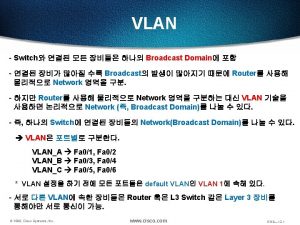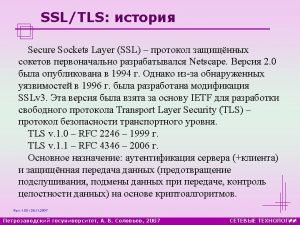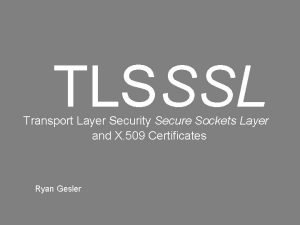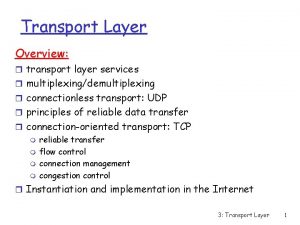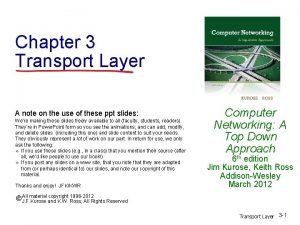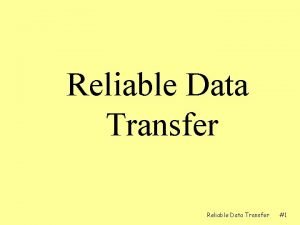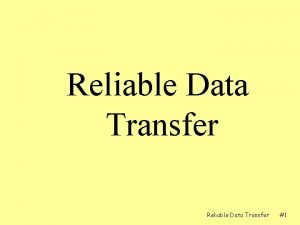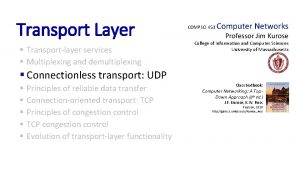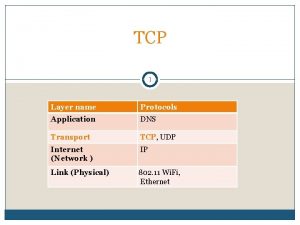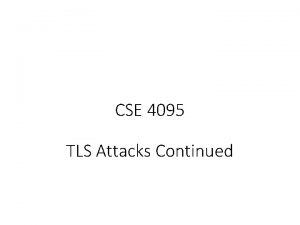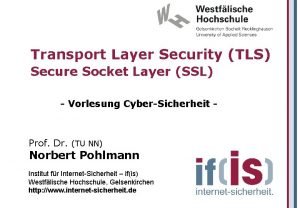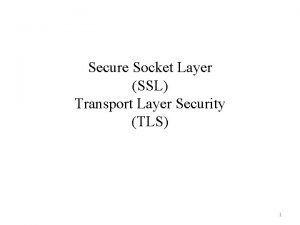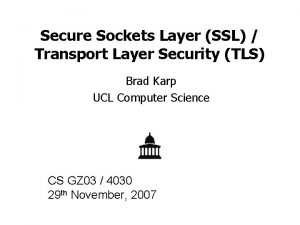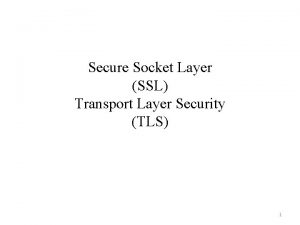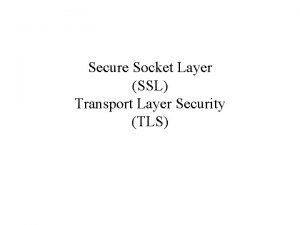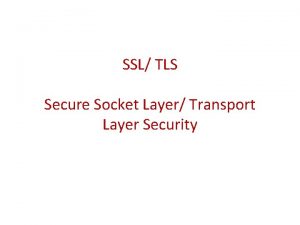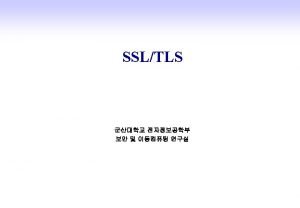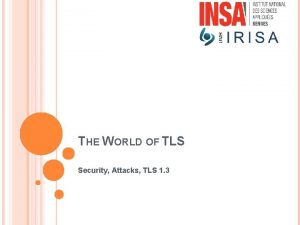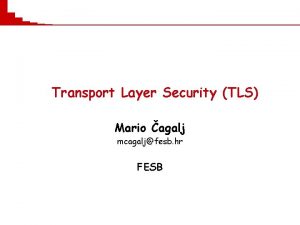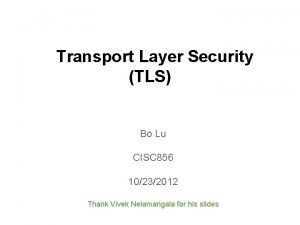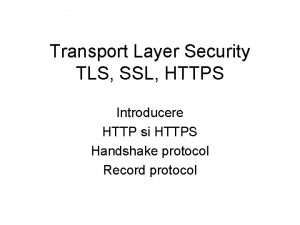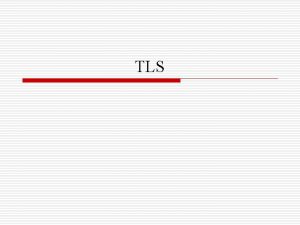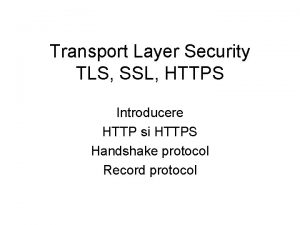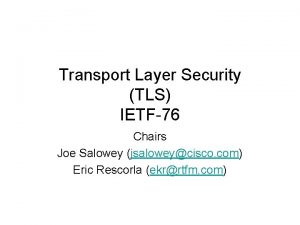CSE 4095 Transport Layer Security TLS 8 1


![SSL/TLS v. SSL (Secure Sockets Layer), predecessor of TLS § mechanisms: [Woo 1994], implementation: SSL/TLS v. SSL (Secure Sockets Layer), predecessor of TLS § mechanisms: [Woo 1994], implementation:](https://slidetodoc.com/presentation_image_h/77dfe1e31655fc05c97237e70b0cd598/image-3.jpg)
























- Slides: 27

CSE 4095 Transport Layer Security TLS 8 -1

So far… v. Link layer security § In particular, security for Wi. Fi network v. IP (network) layer security § IPSec and its usage for VPNs § BGP security v. We have already seen (flavors of) TLS § Wi. Fi security: EAP-TLS, EAP-TTLS § TLS used in VPNs v. TLS § Most important security protocol for the Internet! 8 -2
![SSLTLS v SSL Secure Sockets Layer predecessor of TLS mechanisms Woo 1994 implementation SSL/TLS v. SSL (Secure Sockets Layer), predecessor of TLS § mechanisms: [Woo 1994], implementation:](https://slidetodoc.com/presentation_image_h/77dfe1e31655fc05c97237e70b0cd598/image-3.jpg)
SSL/TLS v. SSL (Secure Sockets Layer), predecessor of TLS § mechanisms: [Woo 1994], implementation: Netscape § SSL V 1 never published (many flaws) § SSL V 2 1995, deprecated in 2011 § SSL V 3 1996, deprecated in 2015 v. TLS (Transport Layer Security) § Substitute SSL in 1999; standardized by IETF § TLS 1. 0, RFC 2246, 1999 § TLS 1. 1, RFC 4346, 2006 8 -3

Goals of SSL/TLS v. Between two end hosts v. Allows client and server to communicate while preventing eavesdropping and tampering v. Provide § Confidentiality (symmetric key encryption) § Message integrity check (through MAC) § Authentication (public key crypto) 8 -4

Usage of SSL/TLS v. Implemented in all (major) web browsers v. Widely used in web browsing (HTTPS), email, instant messaging, voice-over-IP (Vo. IP), … v. Major websites (including Google, You. Tube, Facebook) use TLS v… 8 -5

Think about Google or You. Tube v. Desired properties § Indeed the other side is Google or You. Tube server § Confidentiality: your query, the video you choose § Content from Google or You. Tube has not been modified v. Does TLS give you all the desired properties? 8 -6

SSL/TLS and TCP/IP Application SSL/TLS TCP IP normal application v v v TCP IP application with SSL/TLS: user-level process SSL/TLS provides API to any application that uses TCP SSL libraries/classes readily available for programming languages (C, Java, python…) 8 -7

TLS for UDP? v Datagram Transport Layer Security (DTLS) v First proposed in NDSS, 2004 v RFC 4347, 2006 v Applications § in VPN § some web browsers for real-time communication §… 8 -8

TLS v Handshaking protocol § enable authentication and session key establishment § peers agree upon security parameters for the record layer § report error conditions v Record protocol § Lower layer protocol to support handshaking protocol and application data 8 -9

Handshaking protocol v Three sub-protocols § Handshake Protocol § Change Cipher Spec Protocol § Alert Protocol 8 -10

Handshake Protocol Overview v Runs between a client and a server § e. g. , client: web browser, server: website v Negotiate version of the protocol and the set of cryptographic algorithms to be used § Interoperability between different implementations v Authenticate server and client (optional) § Use digital certificates to learn each other’s public keys and verify each other’s identity § Often only the server is authenticated 8 -11

Handshake Protocol Diagram 8 -12

TLS connection parameters v Two connection ends (client, server) v Bulk encryption algorithm v MAC algorithm v Compression algorithm v Master secret (48 bytes) v Client random (32 byte) v Server random (32 byte) 8 -13

Client. Hello v Client. Random structure (32 bytes) § Client Timestamp § Random 28 byte string v Session. ID § can be empty / it is used for resuming a previous session v Ciphersuite list § List of cryptographic algorithms supported by the client § Key exchange algorithm, bulk encryption algorithm, MAC algorithm, and PRF v Compression list § List of compression algorithms 8 -14

Client. Hello Example TLS 1. 0 8 -15

Server. Hello 8 -16

Server. Hello Example 8 -17

Server Certificate v server provides its certificate to authenticate its name on the public-key it provides to the client v Certificate type MUST be X. 509 v 3, unless explicitly negotiated otherwise 8 -18

Client. Key. Exchange message v Used to set the premaster secret that will allow each side to agree upon the same pre-master secret. § By transmitting the RSA-encrypted secret or Diffie. Hellman parameters 8 -20

Client Authentication v Certificate. Request : server will use this message to request a certificate-based authentication from the client. v Certificate : response to a Certificate. Request message. This will be sent before Client. Key. Exchange 8 -21

Computing master secret v convert the pre_master_secret into the master_secret v Master secret 48 bytes master_secret = PRF(pre_master_secret, "master secret", Client. Hello. random + Server. Hello. random) [0. . 47]; 8 -23

Key generation v master secret is expanded into a sequence of secure bytes v split into § client MAC key § server MAC key § client encryption key § server encryption key § client initialization vector (IV) § server initialization vector (IV) 8 -24

Finished message v To verify key exchange and authentication processes were successful v It is the first message protected with the just negotiated algorithms, keys, and secrets v Recipients of Finished messages MUST verify that the contents are correct v By sending verify_data PRF(master_secret, finished_label, Hash(handshake_messages)) use all handshake msgs up to, but not including this msg 8 -25

TLS Example 8 -26

Why need two random nonces? v Two random nonces § client. random in Client. Hello § server. random in Server. Hello v Deal with playback attacks § They are used to calculate master secret key § Different nonces lead to different master secret key, and hence different sub-keys 8 -27

If no random nonces is being used v Suppose that an attack records all messages between client (Alice) and server (Bob) § Initial messages are not encrypted § Later messages are encrypted § e. g. , This is a transaction that Alice orders a laptop from Bob (Amazon. com) § Attacker replays all messages at a later time § Same master key will be established between attacker and server (Amazon. com) § No client authentication § Alice will be charged to get another laptop! § Attacker can launch the attack although he does not understand every message 8 -28

Why need Finished message? v protect handshake from tampering (Finished messages are encrypted) § client typically offers range of algorithms, some strong, some weak § man-in-the middle could delete stronger algorithms from list § Server is forced to choose a weak algorithm v Verify server and client have the same master key 8 -29
 Secure socket layer and transport layer security
Secure socket layer and transport layer security Secure socket layer and transport layer security
Secure socket layer and transport layer security Secure socket layer and transport layer security
Secure socket layer and transport layer security Secure socket layer and transport layer security
Secure socket layer and transport layer security Vlan id 4095
Vlan id 4095 Osi tls
Osi tls Wireless transport layer security
Wireless transport layer security Multiplexed transport layer security
Multiplexed transport layer security Multiplexed transport layer security
Multiplexed transport layer security Privatesecurity
Privatesecurity Fig 19
Fig 19 Phases of deglutition
Phases of deglutition Layer 6 presentation layer
Layer 6 presentation layer Layer 2 e layer 3
Layer 2 e layer 3 Layer-by-layer assembly
Layer-by-layer assembly Layer 2 vs layer 3 bitstream
Layer 2 vs layer 3 bitstream Transport layer handles multiplexing and demultiplexing
Transport layer handles multiplexing and demultiplexing Atamont fair
Atamont fair Principles of reliable data transfer in transport layer
Principles of reliable data transfer in transport layer Crash recovery in transport layer geeksforgeeks
Crash recovery in transport layer geeksforgeeks Crash recovery in transport layer geeksforgeeks
Crash recovery in transport layer geeksforgeeks Chapter 3 transport layer
Chapter 3 transport layer Selective repeat dilemma
Selective repeat dilemma Reliable data transfer in transport layer
Reliable data transfer in transport layer Multiplexing and demultiplexing in transport layer
Multiplexing and demultiplexing in transport layer Dns transport layer protocol
Dns transport layer protocol Transport layer
Transport layer Mobile transport layer
Mobile transport layer




